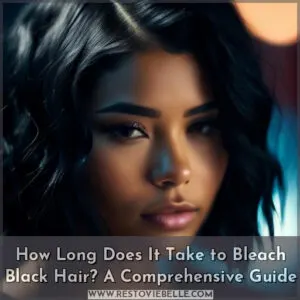This site is supported by our readers. We may earn a commission, at no cost to you, if you purchase through links.
 You shouldn’t rush into bleaching your hair again after a recent session. Hair experts recommend waiting 4-6 weeks before reapplying bleach to avoid severe damage.
You shouldn’t rush into bleaching your hair again after a recent session. Hair experts recommend waiting 4-6 weeks before reapplying bleach to avoid severe damage.
Repeated bleaching without proper gaps risks overprocessing, leading to extreme brittleness, breakage, and even hair loss. The wait allows your strands to regenerate slowly, recovering from the cuticle lifting and inner bond damage caused by bleaching.
Table Of Contents
- Key Takeaways
- How Long Should You Wait to Bleach Your Hair Again?
- Understand the Damage Caused by Bleaching
- Recommended Waiting Time Between Bleach Sessions
- Factors Affecting Waiting Time
- Preparing Your Hair for Bleaching
- Scheduling Lightening Sessions
- Frequently Asked Questions (FAQs)
- How long should I wait before bleaching my hair again?
- How long after bleach can I bleach again?
- How long does it take to bleach your hair?
- Should I bleach my hair for the second time?
- Can you bleach hair while pregnant?
- Is bleaching safe for damaged hair?
- How often can you bleach gray hair?
- What are the signs of overprocessed hair?
- Does coconut oil protect hair from bleach?
- Conclusion
Key Takeaways
- Patience is a virtue, my friend – rushing to re-bleach can leave your locks looking more fried than McDonald’s fries! Give those strands a well-deserved break of 4-6 weeks before the next lightening round.
- Don’t be a glutton for punishment! Bleaching too often is like hitting your hair with a sledgehammer – it’ll snap, crackle, and pop all the way to Breakageville. Take a breather and rejuvenate those tresses.
- Treat your mane like royalty! Pamper it with deep conditioning masks, bonding treatments, and hydrating oils before bleaching. A little TLC goes a long way in keeping your crown intact.
- When in doubt, call in the cavalry. Your hairstylist is the expert – they’ll guide you through the lightening process safely, so you can go blonde without going bald!
How Long Should You Wait to Bleach Your Hair Again?
How long should you wait to bleach your hair again? It’s recommended to wait 4-6 weeks between bleaching sessions to allow your hair to recover and minimize damage. Repeated bleaching too soon can lead to excessive dryness, breakage, and hair loss.
Understand the Damage Caused by Bleaching
Bleaching strips away your hair’s protective outer layer, leaving strands vulnerable to damage. This weakens the inner structure, causing brittleness, dryness, and increased breakage.
Bleaching Lifts Hair Cuticles and Damages Inner Bonds
Bleaching strips away your hair’s protective outer cuticle, exposing the delicate inner structure. This cuticle damage compromises your strands’ integrity, leaving them vulnerable to snapping and breakage. The strong chemicals also weaken the inner bonds that hold your hair together, making it frighteningly fragile. Proceed with caution to avoid extensive damage.
Causes Hair to Become Fragile and Susceptible to Breakage
The bleaching process takes a toll, making your hair fragile and prone to breakage. As harsh chemicals penetrate deep within strands, they weaken the internal bonds holding your hair together. This leaves you vulnerable to excessive shedding and snapping with even minimal styling. Take preventive steps to minimize damage and retain hair integrity.
Leads to Brittleness, Dryness, and Increased Split Ends
You’ll also notice your hair becoming increasingly brittle, dry, and prone to split ends. Combat this by:
- Using a deep conditioning mask weekly
- Applying a hair oil or serum daily
- Getting regular trims
Don’t neglect this essential step – preventing dryness and breakage is key to maintaining healthy hair during the bleaching process.
Recommended Waiting Time Between Bleach Sessions
When bleaching your hair, it’s imperative to wait 4-6 weeks between sessions to allow for adequate recovery and prevent overprocessing. Repeated bleaching without proper rest periods dramatically increases the risk of breakage, as hair regenerates slowly and requires ample time to rebuild its strength.
Wait 4-6 Weeks Between Bleach Sessions
You’ll want to wait 4-6 weeks between bleach sessions to avoid hair-damaging buildup and dye overlap. This timeframe allows your strands to recover porosity and strength before the next round of color correction. For home maintenance, strict adherence to this waiting period is necessary for healthy, vibrant locks.
Longer Wait Times Are Better for Hair Health
You should wait longer than the minimum 4-6 weeks between bleaching sessions. Giving your hair extra time to regenerate is essential for long-term health. Remember, bleaching is an aggressive chemical process – your strands need a break to recover and rebuild strength. Rushing into the next session risks compounding damage and breakage.
Repeated Bleaching Risks Overprocessing and Breakage
Bleaching too frequently risks overprocessing, leaving your hair dry, brittle, and prone to breakage. You’ll strip essential oils and proteins, weakening strands and causing split ends galore. Avoid this hair horror by spacing out bleaching sessions – your hair will thank you for the respite. If unsure, consult a stylist before going platinum again.
Hair Regenerates Slowly Between Treatments
You can’t rush hair rejuvenation after bleaching. Your strands need time to recover, as the process slowly:
- Repairs lifted cuticles
- Restores inner hair bonds
- Strengthens fragile, damaged areas
- Regenerates new, healthy growth
Allowing sufficient rest periods between bleachings prevents overprocessing risks like excessive breakage and potential hair loss. Patience is key for preserving your locks.
Home Bleaching Requires Significant Time Gaps Between Sessions
When bleaching at home, you must allow significant time between sessions for your hair’s health. Chemical damage can quickly accumulate without proper regeneration. Aim for at least two months between bleaching for noticeable regrowth and strengthening. For best results, consult a professional stylist who can guide you through this process safely.
Factors Affecting Waiting Time
The key factors affecting how long you should wait between bleaching sessions are your hair’s type and condition, the strength of bleach used, the number of previous bleaching sessions, and whether you’ve used bonding treatments or deep conditioning. These essential elements determine the ideal waiting period to avoid excessive damage and maintain your hair’s health.
Hair Type and Condition
Your hair’s porosity and overall condition greatly impact how long you should wait between bleaching sessions. Fine, porous hair requires longer gaps, as it’s more vulnerable to damage. Coarse, healthy strands can withstand bleaching sooner. Consider your scalp health too—irritation necessitates extended breaks to heal properly.
Strength of Bleach Used
The strength of the bleach you use impacts how long you should wait before bleaching again. Stronger bleaches like 40 volume require longer breaks compared to gentler options like 20 volume. Consider:
- Volume level of the bleach
- Toner or color correction needs
- Home vs. salon application
- Following product instructions
- Consulting a professional stylist
Pushing too hard too fast causes severe damage, so pace yourself for healthier results.
Number of Previous Bleaching Sessions
The number of previous bleaching sessions prominently influences hair resilience and chemical sensitivity. Increased bleaching correlates with elevated porosity levels and intensified heat damage. This combination amplifies the risk of breakage when rebleaching prematurely. Monitor your hair’s condition diligently – excessive damage may necessitate extended recovery periods between lightening rounds.
Use of Bonding Treatments and Deep Conditioning
You’ve already pushed your hair to the limit with multiple bleaching sessions. Now, using bonding treatments like Olaplex and deep conditioning is essential before your next round. These nourishing steps rebuild compromised bonds and lost moisture, allowing your strands to better withstand the bleach. Give your hair that extra TLC – it’ll thank you by holding up better during lightening.
Preparing Your Hair for Bleaching
Preparing your hair for bleaching is essential to minimize damage. You should consider bonding treatments like Olaplex or K18, reduce hot tool usage, and deeply hydrate and nourish your hair with conditioning treatments and nourishing oils like argan or coconut.
Invest in Bonding Treatments (Olaplex, K18)
Before bleaching, you’ll want to invest in bonding treatments like Olaplex or K18. These strengthen hair bonds and minimize damage from bleaching, especially for home bleaching. With proper bonding, you can preserve hair health and reduce the risk of overprocessing during future lightening sessions. By protecting your strands, bonding buys more time between bleachings.
Reduce Hot Tool Use
Before bleaching, it’s essential to reduce hot tool use to avoid compounding damage. Steer clear of:
- Flat irons that singe strands
- Blow dryers that zap moisture
- Curling wands that create split ends
Instead, explore heatless styling options like braids, buns, and air drying. Your scalp and strands will thank you during the lightening process.
Hydrate and Nourish Hair With Deep Conditioning Treatments
You’ll want to deeply condition your hair before bleaching it. Use nourishing, hydrating hair masks and treatments to replenish moisture and strengthen strands. Focus on scalp care too – a healthy scalp promotes overall hair health. Deep conditioning helps minimize damage from the bleaching process, keeping your locks looking lush.
Use Nourishing Hair Oils (argan, Coconut)
After deep conditioning, nourish your hair with oils like argan or coconut. These hydrating oils help restore moisture and shine lost during bleaching. Massage a few drops into your ends; the nourishment helps prevent breakage when bleaching again. Reducing hot tool use also minimizes damage, keeping your strands strong for your next lightening session.
Scheduling Lightening Sessions
When bleaching your hair, it’s imperative to refrain from misusing strong chemicals, which can lead to hair loss. Consulting with a professional stylist guarantees you receive personalized recommendations for safe lightening sessions that prevent excessive damage.
Strong Chemicals Can Cause Hair Loss if Misused
You can’t be reckless when bleaching your hair. Overusing strong chemicals risks severe damage and even hair loss. If not done properly, the bleaching process strips your strands far beyond what’s necessary for lightening. Play it safe and have a professional assess your hair’s condition before each session to minimize damage risk.
Consult With a Professional Stylist for Personalized Recommendations
Bleaching is serious business—it’s easy to overdo it and fry your locks. That’s why you should consult a pro stylist before attempting any home bleaching. They’ll assess your hair’s condition and provide personalized recommendations, like:
- How long to wait between sessions
- The right bleach strength
- Which bonding treatments to use
- A customized hair restoration plan
With expert guidance, you can keep your hair healthy while achieving your desired shade.
Frequently Asked Questions (FAQs)
How long should I wait before bleaching my hair again?
You should wait 4-6 weeks before bleaching again. Giving your hair ample rest prevents overprocessing and breakage. Listen to your strands – if they feel fragile, wait longer before the next session.
How long after bleach can I bleach again?
Hair don’t lie," goes the old adage. Wait at least 4-6 weeks before re-bleaching. Patience is key to maintaining healthy locks and avoiding over-processing or breakage. Take control – nourish and give your hair time to heal between lightening sessions.
How long does it take to bleach your hair?
Bleaching your hair is a time-intensive process. You’ll need multiple sessions, spaced 4-6 weeks apart, to gradually lift color without damaging strands. Give your hair ample recovery time to avoid brittleness and breakage.
Should I bleach my hair for the second time?
To bleach your hair again, wait 4-6 weeks minimum; bleaching more often risks severe damage. Nourish strands with bonding treatments, conditioning masks – your hair’s health comes first. Done right, you’ll achieve vibrant, long-lasting color without compromising strand integrity.
Can you bleach hair while pregnant?
You shouldn’t bleach hair while pregnant due to potential chemical exposure risks. It’s best to avoid harsh treatments and focus on nourishing your hair during this delicate time. Embrace your natural beauty until after giving birth.
Is bleaching safe for damaged hair?
Bleaching already damaged hair is inadvisable. It’ll worsen brittleness, breakage, and split ends. Focus on nourishing treatments first before considering another lightening session—your strands need TLC!
How often can you bleach gray hair?
For gray hair, you should wait at least 4-6 weeks between bleaching sessions. Frequent bleaching causes excessive damage, leading to breakage and potential hair loss. Allowing ample recovery time preserves the integrity of your strands.
What are the signs of overprocessed hair?
Overprocessed hair looks dull, feels rough, loses elasticity. Strands snap easily, split ends multiply rapidly. You’ll notice excessive shedding during grooming sessions.
Does coconut oil protect hair from bleach?
Coconut oil won’t protect hair from bleach damage. It temporarily coats strands but can’t prevent chemical breakage. Focus on deep conditioning before bleaching to strengthen hair.
Conclusion
Like walking a tightrope, you must balance the desire for lighter locks with protecting your hair’s integrity.
The key to avoiding brittleness and breakage is allowing ample recovery time – at least 4-6 weeks – before reapplying bleach.











